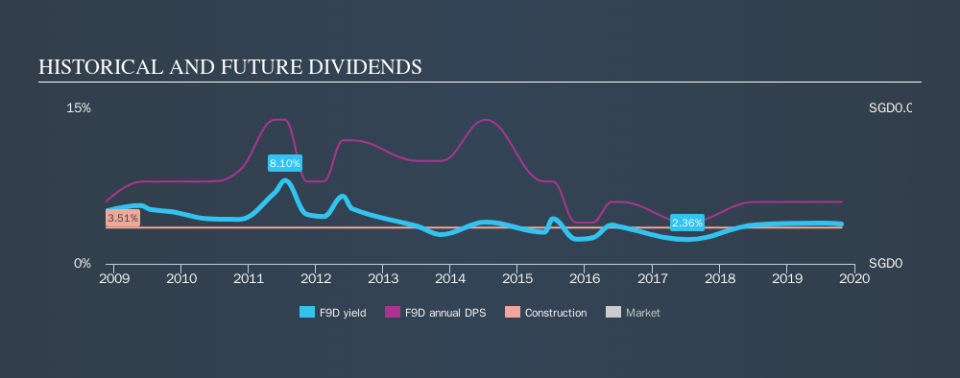Boustead Singapore Limited (SGX:F9D) Is Yielding 3.9% - But Is It A Buy?

Today we'll take a closer look at Boustead Singapore Limited (SGX:F9D) from a dividend investor's perspective. Owning a strong business and reinvesting the dividends is widely seen as an attractive way of growing your wealth. Yet sometimes, investors buy a stock for its dividend and lose money because the share price falls by more than they earned in dividend payments.
With Boustead Singapore yielding 3.9% and having paid a dividend for over 10 years, many investors likely find the company quite interesting. It would not be a surprise to discover that many investors buy it for the dividends. The company also bought back stock during the year, equivalent to approximately 0.7% of the company's market capitalisation at the time. There are a few simple ways to reduce the risks of buying Boustead Singapore for its dividend, and we'll go through these below.
Explore this interactive chart for our latest analysis on Boustead Singapore!
Payout ratios
Companies (usually) pay dividends out of their earnings. If a company is paying more than it earns, the dividend might have to be cut. As a result, we should always investigate whether a company can afford its dividend, measured as a percentage of a company's net income after tax. In the last year, Boustead Singapore paid out 49% of its profit as dividends. A medium payout ratio strikes a good balance between paying dividends, and keeping enough back to invest in the business. Besides, if reinvestment opportunities dry up, the company has room to increase the dividend.
Another important check we do is to see if the free cash flow generated is sufficient to pay the dividend. Boustead Singapore's cash payout ratio in the last year was 35%, which suggests dividends were well covered by cash generated by the business. It's positive to see that Boustead Singapore's dividend is covered by both profits and cash flow, since this is generally a sign that the dividend is sustainable, and a lower payout ratio usually suggests a greater margin of safety before the dividend gets cut.
With a strong net cash balance, Boustead Singapore investors may not have much to worry about in the near term from a dividend perspective.
We update our data on Boustead Singapore every 24 hours, so you can always get our latest analysis of its financial health, here.
Dividend Volatility
From the perspective of an income investor who wants to earn dividends for many years, there is not much point buying a stock if its dividend is regularly cut or is not reliable. Boustead Singapore has been paying dividends for a long time, but for the purpose of this analysis, we only examine the past 10 years of payments. The dividend has been cut by more than 20% on at least one occasion historically. Its most recent annual dividend was S$0.03 per share, effectively flat on its first payment ten years ago.
It's good to see some dividend growth, but the dividend has been cut at least once, and the size of the cut would eliminate most of the growth, anyway. We're not that enthused by this.
Dividend Growth Potential
Given that the dividend has been cut in the past, we need to check if earnings are growing and if that might lead to stronger dividends in the future. Over the past five years, it looks as though Boustead Singapore's EPS have declined at around 15% a year. With this kind of significant decline, we always wonder what has changed in the business. Dividends are about stability, and Boustead Singapore's earnings per share, which support the dividend, have been anything but stable.
Conclusion
To summarise, shareholders should always check that Boustead Singapore's dividends are affordable, that its dividend payments are relatively stable, and that it has decent prospects for growing its earnings and dividend. First, we like that the company's dividend payments appear well covered, although the retained capital also needs to be effectively reinvested. Second, earnings per share have been in decline, and its dividend has been cut at least once in the past. In sum, we find it hard to get excited about Boustead Singapore from a dividend perspective. It's not that we think it's a bad business; just that there are other companies that perform better on these criteria.
You can also discover whether shareholders are aligned with insider interests by checking our visualisation of insider shareholdings and trades in Boustead Singapore stock.
If you are a dividend investor, you might also want to look at our curated list of dividend stocks yielding above 3%.
We aim to bring you long-term focused research analysis driven by fundamental data. Note that our analysis may not factor in the latest price-sensitive company announcements or qualitative material.
If you spot an error that warrants correction, please contact the editor at editorial-team@simplywallst.com. This article by Simply Wall St is general in nature. It does not constitute a recommendation to buy or sell any stock, and does not take account of your objectives, or your financial situation. Simply Wall St has no position in the stocks mentioned. Thank you for reading.

